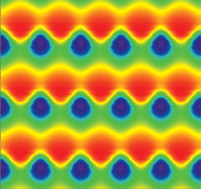Temperature control of pattern formation in the Ru(bpy)32+-catalyzed BZ-AOT system
Abstract
Using temperature as a control parameter, we observe a transition from stationary Turing patterns at T = 15–20 °C to traveling waves at T = 50 °C (and above) in the Ru(bpy)32+-catalyzed Belousov–Zhabotinsky (BZ) reaction incorporated into the water nanodroplets of a water-in-oil aerosol OT (AOT) microemulsion. At constant chemical composition, molar ratio and droplet fraction, the transition takes place via a series of stable patterns, including oscillatory Turing patterns (at 35–40 °C) and reversed oscillatory Turing patterns (at 50 °C). We attribute the pattern transitions to a temperature-induced percolation transition of the BZ-AOT microemulsion, implying a change from isolated water nanodroplets to a system-spanning network of


 Please wait while we load your content...
Please wait while we load your content...